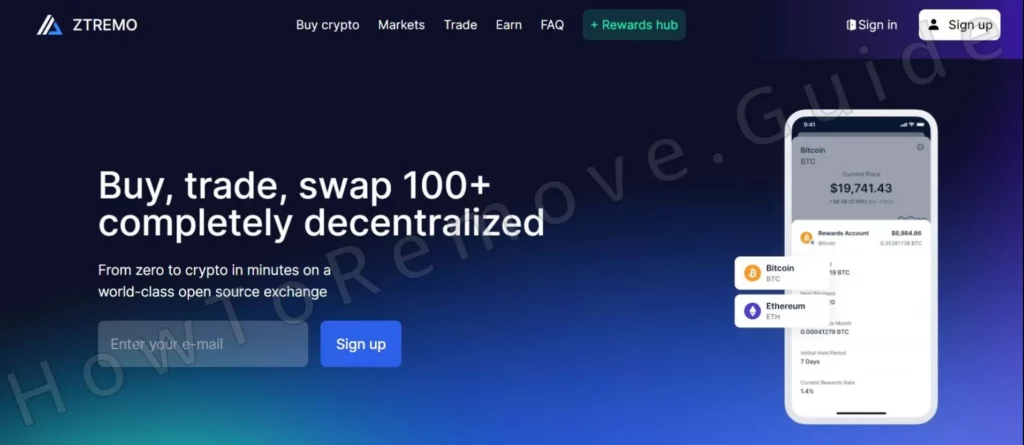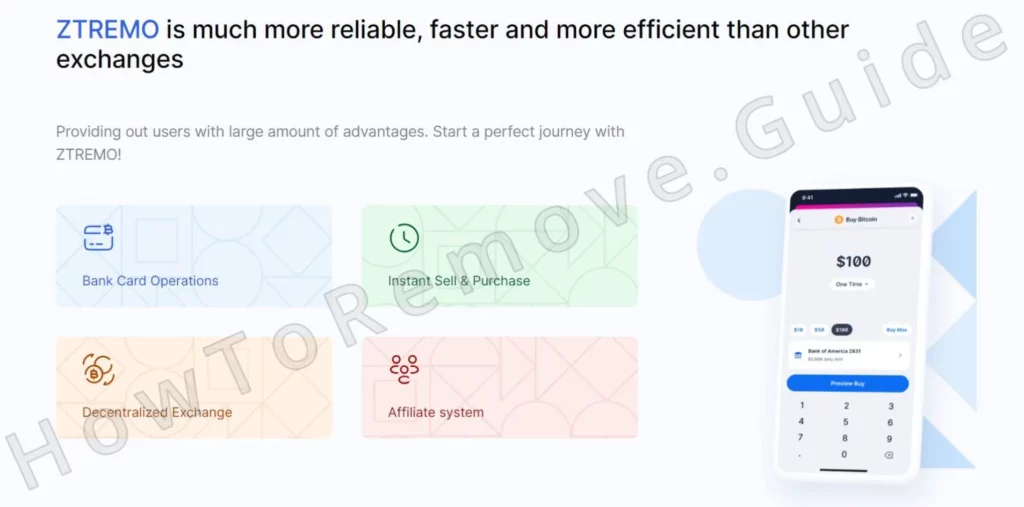If you’ve come across a site called Ztremo.com that promises you enormous returns on any cryptocurrency investments you make on it or directly offers you free crypto for a small transfer fee, do not interact with it or send it anything! Ztremo is a scam site solely designed to steal money from unsuspecting users.
On this page, you can learn more about the characteristics of the Ztremo scam, the way it works, the methods it uses to trick you, and the red flags that give it away. But even if you don’t feel like reading further, remember this – do not interact with anything on the site and leave it immediately to keep your money and virtual privacy secure.

What is the Ztremo Scam?
Ztremo belongs to one of the most common types of crypto scams. Other similar scams are Gistsix and AETRUS. They all use a familiar chain of deception that, once understood, is very easy to spot. That is why you should read the next lines if you want to stay safe from such scams.
Ztremo initially hooks you with an alluring social media post made by a fake profile of a celebrity or another high-profile figure. The post could be just a plain message but, lately, it’s become more and more common for such posts to include deepfakes of the impersonated figure to make the post more convincing.
The post contains a link and promises a large reward in Bitcoin to the first set number of users who click it.
Clicking the link reroutes you to a Ztremo page, where you see the sizeable amount of 0.31 BTC which equals approximately 90k USD. There’s only one requirement to claim it – a 300-400 USD transaction fee that you must pay.
By now, the scam should be obvious – it’s all about that fee. If you pay it, those couple of hundred dollars fall into the hands of the scammers and you’ll never get that money back. As for the reward – it can’t be claimed even after paying the required “fee”. In other words, you’ve been scammed.
What to Do If You’ve Fallen for the Ztremo Cryptocurrency Scam
In case you have indeed fallen for the scam, your “transaction fee” is likely gone for good. You can try reporting the scam and this could eventually result in you restoring your money, but don’t hold your breath.
However, it is critical that you take some important precautions to prevent further damage. The scammers may gain access to your crypto wallet or other sensitive accounts, so you need to act ASAP and secure anything that might be at risk.
The first step involves securing online accounts by updating passwords. Strong passwords deter future breaches. Simple words or familiar sequences offer no security. Password managers, especially, simplify this process. Organized and secure, they guard against future threats.
Two-factor authentication adds another essential layer of protection. Enabling it requires additional steps beyond a password to verify access. This security feature deters unauthorized access effectively.
Reporting the scam to the cryptocurrency platform used offers another line of defense. Some exchanges have fraud support services, allowing users to submit cases for review. National cybercrime agencies also track these reports. Watching for any strange activity across accounts remains vital. Scammers often target victims again, hoping to find fresh vulnerabilities.

Techniques Used by the Ztremo Scam
Understanding these scams and the methods they employ to trick you is how you stay safe from them. Below, you can learn about the most effective and commonly used techniques that make Ztremo and other similar schemes so effective.
- Impersonation – Scammers assume the identities of crypto experts, friends, or influential figures, using statements like “double your investment in days” or “get in early on this rare opportunity.” They establish credibility through these phrases. Posing as insiders, they seem believable. Social media accounts, meanwhile, mirror those of actual celebrities, enhancing the illusion. Trust becomes their weapon.
- Enormous returns – Cryptocurrency investments naturally involve fluctuations and risks. Profits vary, and no one can predict guaranteed returns. Scammers, however, assure users of enormous gains, sometimes as high as 500% in days. Anyone attracted to such promises finds themselves in danger. Unbelievable returns signal fraud, not fortune.
- Fake/phishing sites – These phishing sites trick users into logging in or verifying their information. Scammers harvest login details to access real accounts. Checking URLs carefully can help avoid these pitfalls. A misspelled letter or unfamiliar domain indicates danger. Official sources and verified apps are the safest options.
- Urgency – “Fear of missing out” (FOMO) drives many victims toward quick action. Offers described as “one-time” or “exclusive” tap into people’s anxiety. The pressure prevents careful thought, nudging victims toward rash decisions. Recognizing this urgency helps resist their ploys.
If you use critical thinking whenever you come across a scam like Ztremo.com, you’ll quickly be able to notice each of these methods at work.
The Ztremo Bitcoin Scam- Red Flags
To continue from the previous section, it’s also really important to be aware of the typical red flags present in most scams like Ztremo. These can help you spot the fraud from a mile away as long as you remember to not let your emotions and hopes of quick money overwhelm you:
- High/Guaranteed returns raise immediate suspicion. Cryptocurrencies, while profitable, offer no certainty. Fluctuating values make guarantees impossible. A claim of “triple your investment” or “100% guaranteed profit” almost certainly implies a scam.
- Upfront fees signal more deceit. Scammers disguise fees as “verification costs” or “entry charges.” Legitimate platforms rarely require payment before service. Scammers flee after securing these funds, leaving victims without recourse.
- Fake endorsements fool people into trust. Scammers know familiar faces inspire confidence. Many create fake ads featuring celebrities, faking endorsements from industry leaders. People believe, assuming the names and faces make it credible. Confirming such claims on official websites can verify their legitimacy.
- Unsolicited offers should immediately raise alarms. Trustworthy investment firms seldom initiate contact with users. Unrequested messages or offers generally suggest a scam. If an offer appears without prior contact, approach it skeptically. Seeking validation can prevent missteps.
As the old rule of thumb goes – every time something seems too good to be true, it probably is.
Safely Handling Potential Scam Attempts
If something feels suspicious, cutting contact with the source is essential. Engaging only increases risk. Deleting the message, blocking the sender, and reporting the account help reduce exposure. Avoiding interaction closes the door on potential threats.
Scammers often create websites that appear to be legitimate exchanges. Phishing sites, however, reveal subtle flaws. Checking URLs carefully reveals these details. Domains featuring odd spellings or unusual characters likely signal a scam. Sticking to verified sites or official applications prevents such incidents.
Two-factor authentication strengthens account security. Scammers find it hard to bypass this additional step, even if they acquire a password. This extra verification step proves vital in securing assets.
Protecting Your Cryptocurrency from Future Scams
After a close call or actual scam experience, strengthening account defenses becomes a priority. Running antivirus scans detects hidden threats. Malware often targets login details, remaining undetected. Regular scans reveal and remove potential dangers, safeguarding accounts.
Strong, unique passwords reduce risks further. Familiar phrases or sequences make accounts vulnerable. Consider a hardware wallet for long-term storage, as well. Hardware wallets, unlike digital ones, operate offline. Private keys stored offline protect against hackers who target digital wallets. Offline storage minimizes exposure to online theft, offering extra assurance.
Regular software updates close security gaps. These patches address vulnerabilities scammers often exploit. Outdated systems open doors to cybercriminals. Staying current with updates secures devices against such attempts.
Knowing about scams like Ztremo involves constant awareness and caution. Scammers change tactics quickly, adapting their schemes to fool new targets. Staying informed helps users recognize emerging threats. Knowing red flags, refusing unsolicited offers, and taking active steps to secure accounts are essential practices in the digital finance world. Building a proactive approach ensures protection in an unpredictable landscape.

Leave a Reply